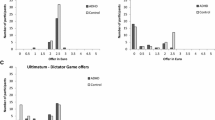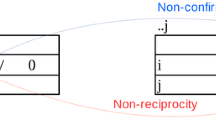Abstract
We examined how the real-life dyadic friendships of 87 children with ADHD and 46 comparison children (76 % boys) aged 7–13 years evolved during a 6-month follow-up period. The methods included friendship quality self-report measures and direct observation of friends’ dyadic behaviors in three structured analogue tasks. At Time 2, the friends of the participants with ADHD reported less positive friendship quality and more conflict with their friends than at Time 1. They were also considerably less satisfied with their friendship than 6 months prior. In contrast, the friends of comparison children reported fewer negative friendship features, more positive friendship features and a slightly greater friendship satisfaction than at Time 1. In sharp contrast with the invited friends’ reports, referred children with ADHD did not report deterioration in their friendship quality over time. Unlike comparison children who significantly reduced violations of game rules between Time 1 and Time 2, children with ADHD broke more game rules during the same period. In negotiating with friends, comparison children, but not children with ADHD, reduced the number of self-centered and insensitive proposals at Time 2. Controlling for Time 1 variance, violations of game rules and a self-centered, insensitive negotiation approach predicted deterioration in friendship quality for children with and without ADHD over time.

Similar content being viewed by others
References
Bagwell, C. L., & Schmidt, M. E. (2011). Friendships in childhood and adolescence. NY: Guilford Press.
Berndt, T. J. (1996). Exploring the effects of friendship quality on social development. In W. M. Bukowski, A. F. Newcomb, & W. W. Hartup (Eds.), The company they keep: Friendship in childhood and adolescence (pp. 19–40). New York: Cambridge Press.
Blachman, D. R., & Hinshaw, S. P. (2002). Patterns of friendship among girls with and without attention-deficit/hyperactivity disorder. Journal of Abnormal Psychology, 30, 625–640. doi:10.1023/A:1020815814973.
Bukowski, W. M., & Hoza, B. (1989). Popularity and friendship: Issues in theory, measurement, and outcome. In T. J. Berndt & G. W. Ladd (Eds.), Peer relationships in child development (pp. 15–45). New York: Wiley.
Conners, C. K., Sitarenios, G., Parker, J. D. A., & Epstein, J. N. (1998a). The revised Conners’ Parent Rating Scale (CPRS-R): factor structure, reliability, and criterion validity. Journal of Abnormal Child Psychology, 26, 257–269. doi:10.1023/A:1022602400621.
Conners, C. K., Sitarenios, G., Parker, J. D. A., & Epstein, J. N. (1998b). The revised Conners’ Teacher Rating Scale (CTRS-R): factor structure, reliability, and criterion validity. Journal of Abnormal Child Psychology, 26, 279–291. doi:10.1023/A:1022606501530.
Fehr, B. (1995). Friendship processes. NY: Sage Publications.
Fonzi, A., Schneider, B. H., Tani, F., & Tomada, G. (1997). Predicting children’s friendship status from their dyadic interaction in structured situations of potential conflict. Child Development, 68, 496–506. doi:10.1111/j.1467-8624.1997.tb01954.x.
Grotpeter, J. K., & Crick, N. R. (1996). Relational aggression, overt aggression, and friendship. Child Development, 67, 2328–2338. doi:10.1111/j.1467-8624.1996.tb01860.x.
Hoza, B., Gerdes, A.C., Mrug, S., Hinshaw, S.P., Bukowski, W.M., Gold, J.A., …Wigal, T. (2005). Peer-assessed outcomes in the multimodal treatment study of children with Attention Deficit Hyperactivity Disorder. Journal of Clinical Child and Adolescent Psychology, 34, 74–86. doi: 10.1207/s15374424jccp3401_7
Hoza, B., Mrug, S., Gerdes, A. C., Hinshaw, S. P., Bukowski, W. M., Gold, J. A., …Arnold, L.E. (2005). What aspects of peer relationships are impaired in children with attention-deficit/hyperactivity disorder? Journal of Consulting and Clinical Psychology, 73, 411–423. doi: 10.1037/0022-006X.73.3.411
Ladd, G. W., Kochenderfer, B. J., & Coleman, C. C. (1996). Friendship quality as a predictor of young children’s early school adjustment. Child Development, 67, 1103–1118. doi:10.1111/j.1467-8624.1996.tb01785.x.
Leff, S. S., Costigan, T., & Power, T. J. (2004). Using participatory research to develop a playground-based prevention program. Journal of School Psychology, 42, 3–21. doi:10.1016/j.jsp.2003.08.005.
Levinger, G. (1980). Toward the analysis of close relationships. Journal of Experimental Social Psychology, 16, 510–544. doi:10.1016/0022-1031(80)90056-6.
Marton, I., Weiner, J., Rogers, M., & Moore, C. (2012). Friendship characteristics of children with ADHD. Journal of Attention Disorders. doi:10.1177/1087054712458971.
Mikami, A. Y. (2010). The importance of friendship for youth with Attention-Deficit/Hyperactivity Disorder. Clinical Child and Family Psychology Review, 13, 181–198.
Mikami, A. Y., Lerner, M. D., Griggs, M. S., McGrath, A., & Calhoun, C. D. (2010). Parental influences on children with Attention-Deficit/Hyperactivity Disorder: II. A pilot intervention training parents as friendship coaches for their children. Journal of Abnormal Child Psychology, 38, 737–749. doi:10.1007/s10802-010-9403-4.
Mrug, S., Hoza, B., Pelham, W. E., Gnagy, E. M., & Greiner, A. R. (2007). Behavior and peer status in children with ADHD: continuity and change. Journal of Attention Disorders, 10, 359–371. doi:10.1177/1087054706288117.
Mrug, S., Molina, B.S.G., Hoza, B., Gerdes, A.C., Hinshaw, S.P., Hechtman, L., & Arnold, L.E. (2012). Peer rejection and friendships in children with ADHD: Contributions to long-term outcomes. Journal of Abnormal Child Psychology. doi:10.1007/s10802-012-9610-2.
Normand, S., Schneider, B. H., Lee, M. D., Maisonneuve, M. F., Kuehn, S. M., & Robaey, P. (2011). How do children with ADHD (mis)manage their real-life dyadic friendships? A multimethod investigation. Journal of Abnormal Child Psychology, 39, 293–305. doi:10.1007/s10802-010-9450-x.
Normand, S., Schneider, B. H., & Robaey, P. (2007). Attention-Deficit/Hyperactivity Disorder and the challenges of close friendship. Journal of the Canadian Academy of Child and Adolescent Psychiatry, 16, 67–73.
Owens, J. S., Goldfine, M., Evangelista, N. M., Hoza, B., & Kaiser, N. M. (2007). Critical review of self-perceptions and the positive illusory bias in children with ADHD. Clinical Child and Family Psychological Review, 10, 335–351. doi:10.1007/s10567-007-0027-3.
Parker, J. G., & Seal, J. (1996). Forming, losing, renewing, and replacing friendships: applying temporal parameters to the assessment of children’s friendship experiences. Child Development, 67, 2248–2268. doi:10.1111/j.1467-8624.1996.tb01855.x.
Rose, A. J., & Asher, S. R. (2000). Children’s friendships. In C. Hendrick & S. S. Hendrick (Eds.), Close relationships: A Sourcebook (pp. 46–57). New York: Sage Publications.
Sagvolden, T., Johansen, E. B., Aase, H., & Russell, V. A. (2005). A dynamic developmental theory of Attention-Deficit/Hyperactivity Disorder (ADHD) predominantly hyperactive/ impulsive and combined subtypes. The Behavioral and Brain Sciences, 28, 397–419. doi:10.1017/S0140525X05000075.
Selman, R. L., Watts, C. L., & Schultz, L. H. (1997). Fostering friendship: Pair therapy for treatment and prevention. Hawthorne: Aldine de Gruyter.
Statistics Canada (2012). Median total income, by family type, by province and territory (couple families). Retrieved October 29, 2012, from Statistics Canada, web site: http://www.statcan.gc.ca/tables-tableaux/sum-som/l01/cst01/famil108b-eng.htm
Walden, T., Lemerise, E., & Smith, M. C. (1999). Friendship and popularity in preschool classrooms. Early Education and Development, 10, 351–371. doi:10.1207/s15566935eed1003_7.
Webster-Stratton, C., & Reid, M. J. (2010). The incredible years parents, teachers, and children training series: A multifaceted treatment approach for young children. In J. Weisz & A. Kazdin (Eds.), Evidence-based psychotherapies for children and adolescents (2nd ed., pp. 194–210). NY: Guilford Press.
Zisser, A., & Eyberg, S. M. (2010). Treating oppositional behavior in children using parent–child interaction therapy. In A. E. Kazdin & J. R. Weisz (Eds.), Evidence-based psychotherapies for children and adolescents (2nd ed., pp. 179–193). NY: Guilford Press.
Acknowledgments
This research was supported by a grant from the Canadian Institutes of Health Research. We express appreciation to all the children, parents, and teachers who participated in our study, and the schools and health professionals who provided referrals. The dedicated assistance of several research assistants, coders, and volunteers is also gratefully acknowledged.
Author information
Authors and Affiliations
Corresponding author
Electronic supplementary material
Below is the link to the electronic supplementary material.
Supplementary Appendix 1
(DOCX 132 kb)
Rights and permissions
About this article
Cite this article
Normand, S., Schneider, B.H., Lee, M.D. et al. Continuities and Changes in the Friendships of Children with and Without ADHD: A Longitudinal, Observational Study. J Abnorm Child Psychol 41, 1161–1175 (2013). https://doi.org/10.1007/s10802-013-9753-9
Published:
Issue Date:
DOI: https://doi.org/10.1007/s10802-013-9753-9




